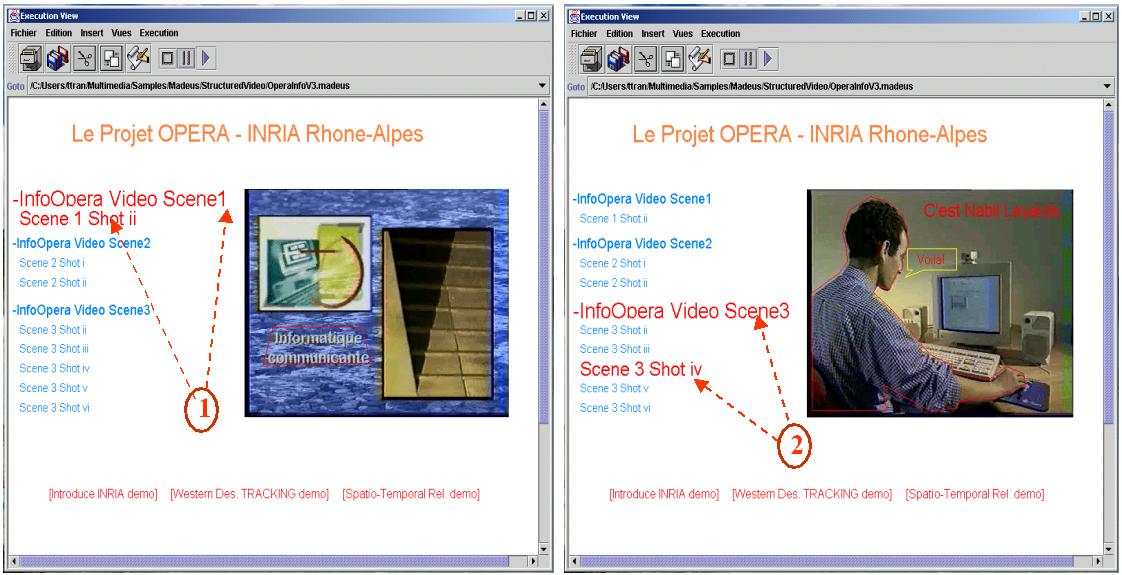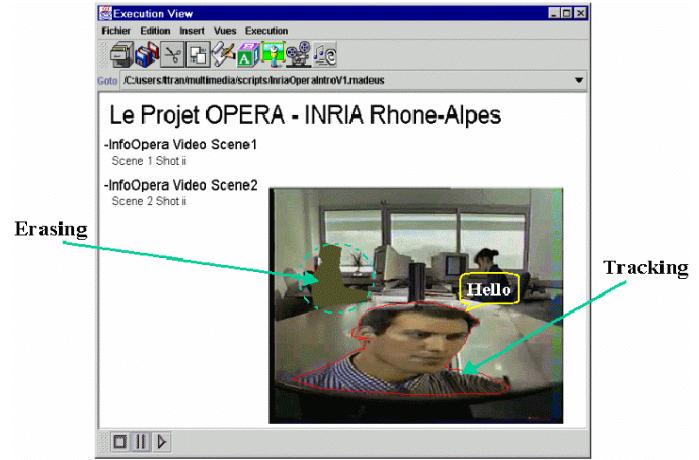
The example presents in this page results from our prototype developed in accordance with our approach. It's the presentation of a multimedia document, which has been edited thanks to our video content description tool. The great interests of this example are: first, the capacities of temporal and spatio-temporal synchronization between the video content and other medias, and secondly, the interactive capabilities of video objects during document presentation.
 |
| Figure 1. Temporally synchronizing the animation on the text and the appearance of the images with the video segments. (0) beginning there aren't any images and texts grown, (1) the Rocquencourt research unit appears on screen starting the appearance of its picture and the growing of the its text, as same as the (2) with the Sophia-Anipolis research unit and finally the (3) Rhône-Alpes research unit. |
Video demo (4M avi) - Source .madeus
These examples are the playout of a multimedia document shortly introducing the five research units of INRIA. The document uses an extraction of a video presentation INRIA. In this video clip the five research units are sequentially appeared. This timing relationship implied in the video clip is made explicit by the sequence relationships of the sub-intervals. The pictures of the units and the animations appended on the texts labeling the research units so easily synchronize with the appearances corresponding of five units by making temporal relationships between the intervals of the pictures and texts with the sub-intervals of the unit appearances.
 |
| Figure 2. Temporally synchronizing the growing and color changing on the text titles with the video segments (scene and shot). (1) the second (Shotii) shot of the first scene (Scene1) is playing, (2) the fourth shot (Shotiv) of the third scene (Scene3) is playing. |
In the same way, the Figure 2 is a document presenting the Opera project. Within it, the text appearances and the animations, both font size and color, are synchronized with the video elements. This document is same as a Slideshow document, in which the titles and its corresponding slide pictures are dependently play out with the parts of the video presenting a talk.
Video demo (7.7M avi) - Source .madeus
The examples are more exciting, in which we use both the sub-interval and the sub-region for spatio-temporal presentation and synchronization of the video objects: the hyperlink on video object (Figure 3); the alignment of a text object corresponding to appearance and motion of a character in the video (Figure 4).
 |
| Figure 3. Hyperlink on video object: the blue contour appears when the mouse moving on the Nabil character meaning the Nabil character has a hyperlink, and the click on this actor generates his page web. |
Video demo (7.7M avi)
Video Hyperlink: The Figure 3 is a screenshot of the multimedia document introducing Opera project. It illustrates a hyperlink action on the Nabil character to access his home page. During the appearance of a video object user can make a link on it. Then during document presentation, when the mouse moves enter the region of the video hyperlink object, a blue contour will be displayed around the video object and the cursor will be changed its look to a hand picture. The video hyperlink is same as a hyper text on the web document, however it is dynamic, i.e., the video hyperlink on a video object is only activated during the appearance of the object, when the object disappears, the user lost the chance to activate the link.
Video demo (7.7M avi)
Spatio-Temporal Synchronization: In this example (Figure 4), author adds a textual speech aligned always on the top during the occurrence of the character. This textual speech is a text media illustrating the word of the character.
Video demo (2.5M avi) - Source .madeus
Tracking: Moreover author can define more operations related to occurrences of characters like: to hide occurrences of a character; or make a focus on video objects by drawing a red contour around the occurrence of character (Figure 4).
Video demo (2.4M avi) - Source .madeus
 |
| Figure 4. Tracking and saptio-temporal synchronization |